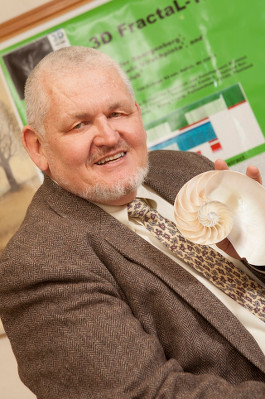
Meeting Abstract
Morphospaces, Adaptive and Epigenetic Landscapes, Phylogenetic Networks, and n-Dimensional Niches are imaginary worlds constructed upon the basis of theoretical models or the mathematical analysis of multivariate data. Their power often lies not only in aesthetics and the improvement of our conceptual understanding, but also in the planning of experiments, the decisions of what field data to collect, or the re-interpretation of already collected data. How do we help biologists interpret and appreciate the mathematical models and analyses that underlie these imaginary worlds? I will illustrate four models that instantiate the paleontologist Dolph Seilacher’s dictum: “I wouldn’t have seen it, if I hadn’t believed it.” Analyses of multivariate, multi-scale nonlinear phenomena require new tools and conceptual approaches. Four of the biological software applications that we have developed are based upon computational geometry, spatial statistics, graph theory, cellular automata, and fractals. Some of the questions that will be addressed are: How do designs emerge without designers? How can complex patterns be generated by simple rules? When do slogans like “survival of the fittest” break down? How do we test trees as hypotheses or ask how tree-like is a network? In this context, mathematics is a lens that helps us see from a perspective. In particular, I believe that if the mathematics is easily accessible to biologists, then they are not only apt to use mathematics, but also they are more likely to understand how mathematics helps them with their work. Furthermore, this approach helps biologists better appreciate Richard Hamming’s dictum that: “The purpose of computing is “insight”, not numbers.
 John R. Jungck is a Professor of Biological Sciences and holds joint appointments in the Department of Mathematical Sciences and the Bioinformatics/Computational Biology Program at the University of Delaware, where he is Director of the Interdisciplinary Science Learning Laboratories. He is a leader in biology education reform and a computer software developer of biological simulations, tools, and databases. He is the founder of the BioQUEST Curriculum Consortium (http://bioquest.org ), and PI of several educational initiatives: BEDROCK (Bioinformatics Education Dissemination: Reaching Out, Connecting, and Knittingtogether), the SELECTION Working Group of the National Evolutionary Synthesis Center (NESCent), and of a subcontract for NUMB3R5 COUNT! (Numerical Undergraduate Mathematical Biology Education). He is a mathematical molecular evolutionary biologist, with research interests in bioinformatics, the origins of genetic codes, image analysis and simulation of patterns in nature, evolutionary analysis of complex data sets and interdisciplinary education. Dr. Jungck has served as editor and on editorial boards of several journals and has received numerous awards for his work in mathematical biology and education including AAAS Fellow, the ASCB Bruce Alberts Award, and an AIBS Education Award.
John R. Jungck is a Professor of Biological Sciences and holds joint appointments in the Department of Mathematical Sciences and the Bioinformatics/Computational Biology Program at the University of Delaware, where he is Director of the Interdisciplinary Science Learning Laboratories. He is a leader in biology education reform and a computer software developer of biological simulations, tools, and databases. He is the founder of the BioQUEST Curriculum Consortium (http://bioquest.org ), and PI of several educational initiatives: BEDROCK (Bioinformatics Education Dissemination: Reaching Out, Connecting, and Knittingtogether), the SELECTION Working Group of the National Evolutionary Synthesis Center (NESCent), and of a subcontract for NUMB3R5 COUNT! (Numerical Undergraduate Mathematical Biology Education). He is a mathematical molecular evolutionary biologist, with research interests in bioinformatics, the origins of genetic codes, image analysis and simulation of patterns in nature, evolutionary analysis of complex data sets and interdisciplinary education. Dr. Jungck has served as editor and on editorial boards of several journals and has received numerous awards for his work in mathematical biology and education including AAAS Fellow, the ASCB Bruce Alberts Award, and an AIBS Education Award.

